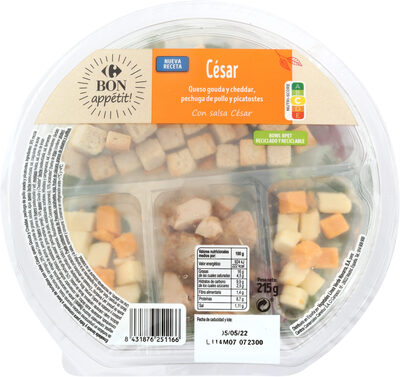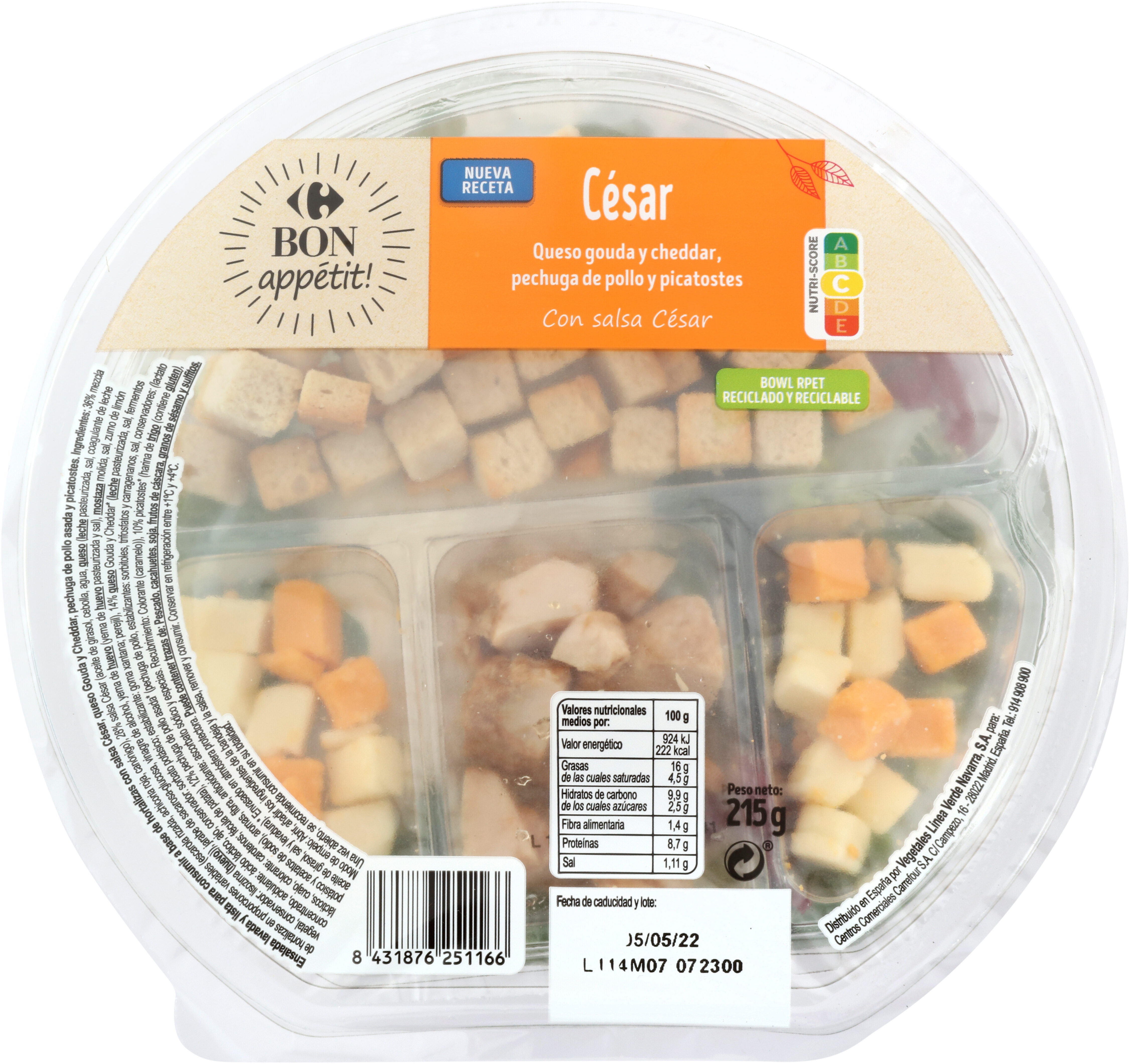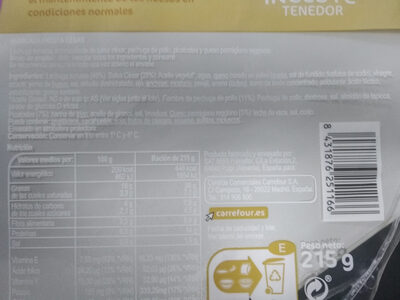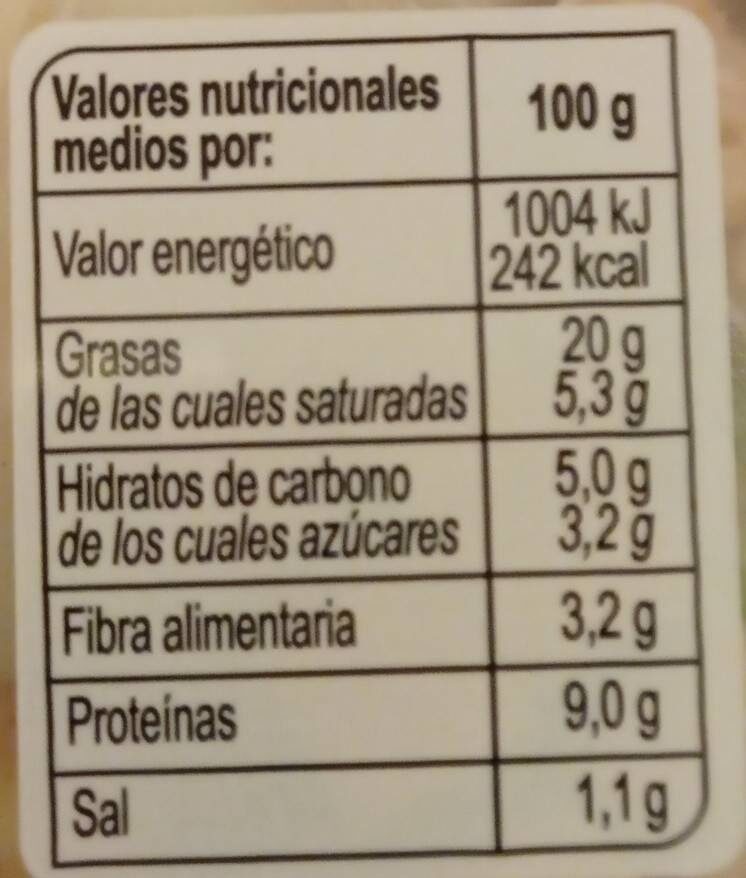Help us make food transparency the norm!
As a non-profit organization, we depend on your donations to continue informing consumers around the world about what they eat.
The food revolution starts with you!
Ensalada césar - Carrefour - 215 g
Ensalada césar - Carrefour - 215 g
This product page is not complete. You can help to complete it by editing it and adding more data from the photos we have, or by taking more photos using the app for Android or iPhone/iPad. Thank you!
×
Some of the data for this product has been provided directly by the manufacturer Carrefour España.
Barra-kodea: 8431876251166 (EAN / EAN-13)
Kopurua: 215 g
Markak: Carrefour, Bon appetit
Kategoriak: en:Plant-based foods and beverages, en:Plant-based foods, en:Fruits and vegetables based foods, en:Meals, en:Prepared salads, en:Caesar salads, en:salads
Etiketak, ziurtagiriak, sariak:
en:Organic, en:Green Dot
Dendak: Carrefour
Saltzen diren herrialdeak: Espainia
Matching with your preferences
Health
Osagaiak
-
59 ingredients
: Hortalizas en proporción variable (36%): escarola rizada, radicchio, canónigos. Salsa césar (28%): Aceite vegetal*, agua, queso curado en polvo (queso, sal de fundido: fosfatos de sodio), vinagre, azúcar, yema de huevo, sal, cebolla deshidratada, ajo, anchoas, mostaza, perejil, aroma (contiene derivado/s de la leche), zumo de limón concentrado, acidulante: ácido láctico, estabilizante: goma xantana. *Aceite girasol: AG, aceite de soja: AS o aceite de nabina AN (Ver siglas junto al lote). Queso gouda y cheddar (14%): Queso gouda: (Leche pasteurizada de vaca, sal, fermentos lácticos, coagulante de leche microbiano, antiaglomerate: almidón de patata), Queso cheddar(Leche pasterurzada de vaca, sal, fermentos lácticos, coagulante de leche microbiano, colorante (beta-caroteno de Blakeslea trispora), antiaglomerante: almidón de patata). Fiambre de pechuga de pollo (12%): pechuga de pollo, dextrosa, sal, almidón de tapioca, jarabe de glucosa, D-xilosa. Picatostes (10%): harina de trigo, aceite de girasol, sal, levadura.Alergenoak: en:Eggs, en:Gluten, en:Milk, en:Mustard, es:anchoasAztarnak: en:Nuts, en:Peanuts
Food processing
-
Ultra processed foods
Elements that indicate the product is in the 4 - Ultra prozesatutako elikagaiak eta edariak group:
- Gehigarria: E160a
- Gehigarria: E415
- Osagaia: Colour
- Osagaia: Dextrose
- Osagaia: Flavouring
- Osagaia: Glukosa
- Osagaia: Almibar
Food products are classified into 4 groups according to their degree of processing:
- Prozesatu gabeko edo ahalik eta gutxien prozesatutako elikagaiak
- Sukaldaritzako osagaiak prozesatu
- Prozesatutako jakiak
- Ultra processed foods
The determination of the group is based on the category of the product and on the ingredients it contains.
Gehigarriak
-
E160a
Carotene: The term carotene -also carotin, from the Latin carota, "carrot"- is used for many related unsaturated hydrocarbon substances having the formula C40Hx, which are synthesized by plants but in general cannot be made by animals -with the exception of some aphids and spider mites which acquired the synthesizing genes from fungi-. Carotenes are photosynthetic pigments important for photosynthesis. Carotenes contain no oxygen atoms. They absorb ultraviolet, violet, and blue light and scatter orange or red light, and -in low concentrations- yellow light. Carotenes are responsible for the orange colour of the carrot, for which this class of chemicals is named, and for the colours of many other fruits, vegetables and fungi -for example, sweet potatoes, chanterelle and orange cantaloupe melon-. Carotenes are also responsible for the orange -but not all of the yellow- colours in dry foliage. They also -in lower concentrations- impart the yellow coloration to milk-fat and butter. Omnivorous animal species which are relatively poor converters of coloured dietary carotenoids to colourless retinoids have yellowed-coloured body fat, as a result of the carotenoid retention from the vegetable portion of their diet. The typical yellow-coloured fat of humans and chickens is a result of fat storage of carotenes from their diets. Carotenes contribute to photosynthesis by transmitting the light energy they absorb to chlorophyll. They also protect plant tissues by helping to absorb the energy from singlet oxygen, an excited form of the oxygen molecule O2 which is formed during photosynthesis. β-Carotene is composed of two retinyl groups, and is broken down in the mucosa of the human small intestine by β-carotene 15‚15'-monooxygenase to retinal, a form of vitamin A. β-Carotene can be stored in the liver and body fat and converted to retinal as needed, thus making it a form of vitamin A for humans and some other mammals. The carotenes α-carotene and γ-carotene, due to their single retinyl group -β-ionone ring-, also have some vitamin A activity -though less than β-carotene-, as does the xanthophyll carotenoid β-cryptoxanthin. All other carotenoids, including lycopene, have no beta-ring and thus no vitamin A activity -although they may have antioxidant activity and thus biological activity in other ways-. Animal species differ greatly in their ability to convert retinyl -beta-ionone- containing carotenoids to retinals. Carnivores in general are poor converters of dietary ionone-containing carotenoids. Pure carnivores such as ferrets lack β-carotene 15‚15'-monooxygenase and cannot convert any carotenoids to retinals at all -resulting in carotenes not being a form of vitamin A for this species-; while cats can convert a trace of β-carotene to retinol, although the amount is totally insufficient for meeting their daily retinol needs.Source: Wikipedia (Ingeles)
-
E270
Lactic acid: Lactic acid is an organic compound with the formula CH3CH-OH-COOH. In its solid state, it is white and water-soluble. In its liquid state, it is colorless. It is produced both naturally and synthetically. With a hydroxyl group adjacent to the carboxyl group, lactic acid is classified as an alpha-hydroxy acid -AHA-. In the form of its conjugate base called lactate, it plays a role in several biochemical processes. In solution, it can ionize a proton from the carboxyl group, producing the lactate ion CH3CH-OH-CO−2. Compared to acetic acid, its pKa is 1 unit less, meaning lactic acid deprotonates ten times more easily than acetic acid does. This higher acidity is the consequence of the intramolecular hydrogen bonding between the α-hydroxyl and the carboxylate group. Lactic acid is chiral, consisting of two optical isomers. One is known as L--+--lactic acid or -S--lactic acid and the other, its mirror image, is D--−--lactic acid or -R--lactic acid. A mixture of the two in equal amounts is called DL-lactic acid, or racemic lactic acid. Lactic acid is hygroscopic. DL-lactic acid is miscible with water and with ethanol above its melting point which is around 17 or 18 °C. D-lactic acid and L-lactic acid have a higher melting point. In animals, L-lactate is constantly produced from pyruvate via the enzyme lactate dehydrogenase -LDH- in a process of fermentation during normal metabolism and exercise. It does not increase in concentration until the rate of lactate production exceeds the rate of lactate removal, which is governed by a number of factors, including monocarboxylate transporters, concentration and isoform of LDH, and oxidative capacity of tissues. The concentration of blood lactate is usually 1–2 mM at rest, but can rise to over 20 mM during intense exertion and as high as 25 mM afterward. In addition to other biological roles, L-lactic acid is the primary endogenous agonist of hydroxycarboxylic acid receptor 1 -HCA1-, which is a Gi/o-coupled G protein-coupled receptor -GPCR-.In industry, lactic acid fermentation is performed by lactic acid bacteria, which convert simple carbohydrates such as glucose, sucrose, or galactose to lactic acid. These bacteria can also grow in the mouth; the acid they produce is responsible for the tooth decay known as caries. In medicine, lactate is one of the main components of lactated Ringer's solution and Hartmann's solution. These intravenous fluids consist of sodium and potassium cations along with lactate and chloride anions in solution with distilled water, generally in concentrations isotonic with human blood. It is most commonly used for fluid resuscitation after blood loss due to trauma, surgery, or burns.Source: Wikipedia (Ingeles)
-
E415
Xanthan gum: Xanthan gum -- is a polysaccharide with many industrial uses, including as a common food additive. It is an effective thickening agent and stabilizer to prevent ingredients from separating. It can be produced from simple sugars using a fermentation process, and derives its name from the species of bacteria used, Xanthomonas campestris.Source: Wikipedia (Ingeles)
Ingredients analysis
-
en:May contain palm oil
Ingredients that may contain palm oil: Landare-olio, E160aiii
-
en:Non-vegan
Non-vegan ingredients: en:Cured cheese, Gazta, Gorringo, en:Anchovy, Gouda gazta, en:Pasteurised cow's milk, Cheddar gazta, en:Chicken breastSome ingredients could not be recognized.
We need your help!
You can help us recognize more ingredients and better analyze the list of ingredients for this product and others:
- Edit this product page to correct spelling mistakes in the ingredients list, and/or to remove ingredients in other languages and sentences that are not related to the ingredients.
- Add new entries, synonyms or translations to our multilingual lists of ingredients, ingredient processing methods, and labels.
If you would like to help, join the #ingredients channel on our Slack discussion space and/or learn about ingredients analysis on our wiki. Thank you!
-
en:Non-vegetarian
Non-vegetarian ingredients: en:Anchovy, en:Chicken breastSome ingredients could not be recognized.
We need your help!
You can help us recognize more ingredients and better analyze the list of ingredients for this product and others:
- Edit this product page to correct spelling mistakes in the ingredients list, and/or to remove ingredients in other languages and sentences that are not related to the ingredients.
- Add new entries, synonyms or translations to our multilingual lists of ingredients, ingredient processing methods, and labels.
If you would like to help, join the #ingredients channel on our Slack discussion space and/or learn about ingredients analysis on our wiki. Thank you!
-
Details of the analysis of the ingredients
We need your help!
Some ingredients could not be recognized.
We need your help!
You can help us recognize more ingredients and better analyze the list of ingredients for this product and others:
- Edit this product page to correct spelling mistakes in the ingredients list, and/or to remove ingredients in other languages and sentences that are not related to the ingredients.
- Add new entries, synonyms or translations to our multilingual lists of ingredients, ingredient processing methods, and labels.
If you would like to help, join the #ingredients channel on our Slack discussion space and/or learn about ingredients analysis on our wiki. Thank you!
: Hortalizas en proporción variable 36% (escarola rizada), radicchio, canónigos, Salsa césar 28% (Aceite vegetal), agua, queso curado (queso, sal de fundido (fosfatos de sodio)), vinagre, azúcar, yema de huevo, sal, cebolla deshidratada, ajo, anchoas, mostaza, perejil, aroma (contiene derivado, s de la leche), zumo de limón concentrado, acidulante (ácido láctico), estabilizante (goma xantana, Aceite girasol), AG, aceite de soja, Queso gouda (Leche pasteurizada de vaca), sal, fermentos lácticos, coagulante de leche microbiano, antiaglomerate (almidón de patata), Queso cheddar (Leche pasterurzada de vaca, sal, fermentos lácticos, coagulante de leche microbiano, colorante (beta-caroteno de Blakeslea trispora), antiaglomerante (almidón de patata)), Fiambre de pechuga de pollo 12% (pechuga de pollo), dextrosa, sal, almidón de tapioca, jarabe de glucosa, D-xilosa, Picatostes 10% (harina de trigo), aceite de girasol, sal, levadura- Hortalizas en proporción variable -> en:vegetables-in-variable-proportion - vegan: yes - vegetarian: yes - percent: 36
- escarola rizada -> en:curly-endive - vegan: yes - vegetarian: yes - ciqual_food_code: 20012
- radicchio -> en:radicchio - vegan: yes - vegetarian: yes
- canónigos -> en:corn-salad - vegan: yes - vegetarian: yes - ciqual_food_code: 20099
- Salsa césar -> es:salsa-cesar - percent: 28
- Aceite vegetal -> en:vegetable-oil - vegan: yes - vegetarian: yes - from_palm_oil: maybe
- agua -> en:water - vegan: yes - vegetarian: yes - ciqual_food_code: 18066
- queso curado -> en:cured-cheese - vegan: no - vegetarian: maybe - ciqual_proxy_food_code: 12999
- queso -> en:cheese - vegan: no - vegetarian: maybe - ciqual_proxy_food_code: 12999
- sal de fundido -> en:emulsifying-salts
- fosfatos de sodio -> en:e339 - vegan: yes - vegetarian: yes
- vinagre -> en:vinegar - vegan: yes - vegetarian: yes - ciqual_food_code: 11018
- azúcar -> en:sugar - vegan: yes - vegetarian: yes - ciqual_proxy_food_code: 31016
- yema de huevo -> en:egg-yolk - vegan: no - vegetarian: yes - ciqual_food_code: 22002
- sal -> en:salt - vegan: yes - vegetarian: yes - ciqual_food_code: 11058
- cebolla deshidratada -> en:dehydrated-onion - vegan: yes - vegetarian: yes - ciqual_food_code: 20180
- ajo -> en:garlic - vegan: yes - vegetarian: yes - ciqual_food_code: 11000
- anchoas -> en:anchovy - vegan: no - vegetarian: no - ciqual_food_code: 26079
- mostaza -> en:mustard - ciqual_food_code: 11013
- perejil -> en:parsley - vegan: yes - vegetarian: yes - ciqual_proxy_food_code: 11014
- aroma -> en:flavouring - vegan: maybe - vegetarian: maybe
- contiene derivado -> es:contiene-derivado
- s de la leche -> es:s-de-la-leche
- zumo de limón concentrado -> en:concentrated-lemon-juice - vegan: yes - vegetarian: yes - ciqual_food_code: 2028
- acidulante -> en:acid
- ácido láctico -> en:e270 - vegan: yes - vegetarian: yes
- estabilizante -> en:stabiliser
- goma xantana -> en:e415 - vegan: yes - vegetarian: yes
- Aceite girasol -> en:sunflower-oil - vegan: yes - vegetarian: yes - from_palm_oil: no - ciqual_food_code: 17440
- AG -> es:ag
- aceite de soja -> en:soya-oil - vegan: yes - vegetarian: yes - from_palm_oil: no - ciqual_food_code: 17420
- Queso gouda -> en:gouda - vegan: no - vegetarian: maybe - ciqual_food_code: 12736
- Leche pasteurizada de vaca -> en:pasteurised-cow-s-milk - vegan: no - vegetarian: yes - ciqual_proxy_food_code: 19051
- sal -> en:salt - vegan: yes - vegetarian: yes - ciqual_food_code: 11058
- fermentos lácticos -> en:lactic-ferments - vegan: maybe - vegetarian: yes
- coagulante de leche microbiano -> en:microbial-coagulating-enzyme - vegan: yes - vegetarian: yes
- antiaglomerate -> es:antiaglomerate
- almidón de patata -> en:potato-starch - vegan: yes - vegetarian: yes - ciqual_proxy_food_code: 9510
- Queso cheddar -> en:cheddar - vegan: no - vegetarian: maybe - ciqual_food_code: 12726
- Leche pasterurzada de vaca -> es:leche-pasterurzada-de-vaca
- sal -> en:salt - vegan: yes - vegetarian: yes - ciqual_food_code: 11058
- fermentos lácticos -> en:lactic-ferments - vegan: maybe - vegetarian: yes
- coagulante de leche microbiano -> en:microbial-coagulating-enzyme - vegan: yes - vegetarian: yes
- colorante -> en:colour
- beta-caroteno de Blakeslea trispora -> en:e160aiii - vegan: yes - vegetarian: yes - from_palm_oil: maybe
- antiaglomerante -> en:anti-caking-agent
- almidón de patata -> en:potato-starch - vegan: yes - vegetarian: yes - ciqual_proxy_food_code: 9510
- Fiambre de pechuga de pollo -> es:fiambre-de-pechuga-de-pollo - percent: 12
- pechuga de pollo -> en:chicken-breast - vegan: no - vegetarian: no - ciqual_food_code: 36018
- dextrosa -> en:dextrose - vegan: yes - vegetarian: yes - ciqual_proxy_food_code: 31016
- sal -> en:salt - vegan: yes - vegetarian: yes - ciqual_food_code: 11058
- almidón de tapioca -> en:tapioca - vegan: yes - vegetarian: yes - ciqual_proxy_food_code: 9510
- jarabe de glucosa -> en:glucose-syrup - vegan: yes - vegetarian: yes - ciqual_proxy_food_code: 31016
- D-xilosa -> es:d-xilosa
- Picatostes -> es:picatostes - percent: 10
- harina de trigo -> en:wheat-flour - vegan: yes - vegetarian: yes - ciqual_proxy_food_code: 9410
- aceite de girasol -> en:sunflower-oil - vegan: yes - vegetarian: yes - from_palm_oil: no - ciqual_food_code: 17440
- sal -> en:salt - vegan: yes - vegetarian: yes - ciqual_food_code: 11058
- levadura -> en:yeast - vegan: yes - vegetarian: yes
Elikadura
-
Average nutritional quality
This product is not considered a beverage for the calculation of the Nutri-Score.
Positive points: 4
- Proteinak: 5 / 5 (balioa: 9, rounded value: 9)
- Fiber: 3 / 5 (balioa: 3.2, rounded value: 3.2)
- Fruits, vegetables, nuts, and colza/walnut/olive oils: 1 / 5 (balioa: 46, rounded value: 46)
Negative points: 11
- Energia: 2 / 10 (balioa: 1004, rounded value: 1004)
- Azukreak: 0 / 10 (balioa: 3.2, rounded value: 3.2)
- Gantz saturatua: 5 / 10 (balioa: 5.3, rounded value: 5.3)
- Sodioa: 4 / 10 (balioa: 440, rounded value: 440)
The points for proteins are not counted because the negative points are greater or equal to 11.
Nutritional score: (11 - 4)
Nutri-Score:
-
Nutrient levels
-
Koipe in moderate quantity (20%)
What you need to know- A high consumption of fat, especially saturated fats, can raise cholesterol, which increases the risk of heart diseases.
Recommendation: Limit the consumption of fat and saturated fat- Choose products with lower fat and saturated fat content.
-
Gantz-azido ase in high quantity (5.3%)
What you need to know- A high consumption of fat, especially saturated fats, can raise cholesterol, which increases the risk of heart diseases.
Recommendation: Limit the consumption of fat and saturated fat- Choose products with lower fat and saturated fat content.
-
Azukre in low quantity (3.2%)
What you need to know- A high consumption of sugar can cause weight gain and tooth decay. It also augments the risk of type 2 diabetes and cardio-vascular diseases.
Recommendation: Limit the consumption of sugar and sugary drinks- Sugary drinks (such as sodas, fruit beverages, and fruit juices and nectars) should be limited as much as possible (no more than 1 glass a day).
- Choose products with lower sugar content and reduce the consumption of products with added sugars.
-
Gatz arrunt in moderate quantity (1.1%)
What you need to know- A high consumption of salt (or sodium) can cause raised blood pressure, which can increase the risk of heart disease and stroke.
- Many people who have high blood pressure do not know it, as there are often no symptoms.
- Most people consume too much salt (on average 9 to 12 grams per day), around twice the recommended maximum level of intake.
Recommendation: Limit the consumption of salt and salted food- Reduce the quantity of salt used when cooking, and don't salt again at the table.
- Limit the consumption of salty snacks and choose products with lower salt content.
-
-
Nutrition facts
Nutrition facts As sold
for 100 g / 100 mlCompared to: en:Caesar salads Energia 1.004 kj
(242 kcal)+% 38 Koipe 20 g +% 80 Gantz-azido ase 5,3 g +% 56 Carbohydrates 5 g -% 47 Azukre 3,2 g +% 41 Fiber 3,2 g Proteina 9 g +% 15 Gatz arrunt 1,1 g +% 11 Fruits‚ vegetables‚ nuts and rapeseed‚ walnut and olive oils 46 % Fruits‚ vegetables‚ nuts and rapeseed‚ walnut and olive oils (estimate from ingredients list analysis) 84 %
Ingurumena
-
Eco-Score C - Moderate environmental impact
The Eco-Score is an experimental score that summarizes the environmental impacts of food products.→ The Eco-Score was initially developped for France and it is being extended to other European countries. The Eco-Score formula is subject to change as it is regularly improved to make it more precise and better suited to each country.Life cycle analysis
-
Average impact of products of the same category: B (Score: 66/100)
Kategoria: Caesar's salad (salad, chicken, croûtons, sauce)
Kategoria: Caesar's salad (salad, chicken, croûtons, sauce)
- PEF environmental score: 0.38 (the lower the score, the lower the impact)
- including impact on climate change: 3.14 kg CO2 eq/kg of product
Stage Impact Agriculture
78.5 %Processing
8.5 %Ontziratzea
4.8 %Transportation
5.1 %Distribution
2.4 %Consumption
0.6 %
Bonuses and maluses
-
Origins of ingredients with a high impact
Malus: -5
Environmental policy: -5
Transportation: 0
Origin of the product and/or its ingredients % of ingredients Impact Unknown 100 %Altua Amerikar Samoa 0 %Altua
-
Missing packaging information for this product
Malus: -15
⚠ ️ The information about the packaging of this product is not filled in.⚠ ️ For a more precise calculation of the Eco-Score, you can modify the product page and add them.
If you are the manufacturer of this product, you can send us the information with our free platform for producers.
Eco-Score for this product
-
Impact for this product: C (Score: 46/100)
Produktua: Ensalada césar - Carrefour - 215 g
Life cycle analysis score: 66
Sum of bonuses and maluses: -20
Final score: 46/100
-
Carbon footprint
-
Equal to driving 1.6 km in a petrol car
314 g CO² per 100g of product
The carbon emission figure comes from ADEME's Agribalyse database, for the category: Caesar's salad (salad, chicken, croûtons, sauce) (Source: ADEME Agribalyse Database)
Stage Impact Agriculture
71.1 %Processing
10.8 %Ontziratzea
8.8 %Transportation
7.8 %Distribution
1.2 %Consumption
0.2 %
Ontziratzea
-
Missing packaging information for this product
⚠ ️ The information about the packaging of this product is not filled in.Take a photo of the recycling information Take a photo of the recycling information
Transportation
-
Origins of ingredients
Origins of ingredients with a high impact
Origin of the product and/or its ingredients % of ingredients Impact Unknown 100 %Altua Amerikar Samoa 0 %Altua
Report a problem
-
Incomplete or incorrect information?
Category, labels, ingredients, allergens, nutritional information, photos etc.
If the information does not match the information on the packaging, please complete or correct it. Open Food Facts is a collaborative database, and every contribution is useful for all.
Datuen iturria
Product added on by elcoco
Last edit of product page on by org-carrefour-espana.
Produktuaren orria -gatik editatua belenvl, ecoscore-impact-estimator, elcoco.850a85d7fc04beca9a44797de90e1618, kiliweb, openfoodfacts-contributors, rmcramiro, roboto-app, segundo, spotter, teolemon, thaialagata, yuka.AK5INfOsMuwZGPGN4Kco8hWbD_f5GqEFNGICoQ, yuka.AKJpOviwFcEMMdzb7549hRaSC-3NLuV1AmJdow, yuka.UW9jNFBKWW91TmNFby9kbTRnbmt3KzF2NEp5NVFXZm5FL2NNSWc9PQ, yuka.sY2b0xO6T85zoF3NwEKvlm4YCMX1jGr5Og76hU-U7_2JFMXRUcNsuq2hOKs.











